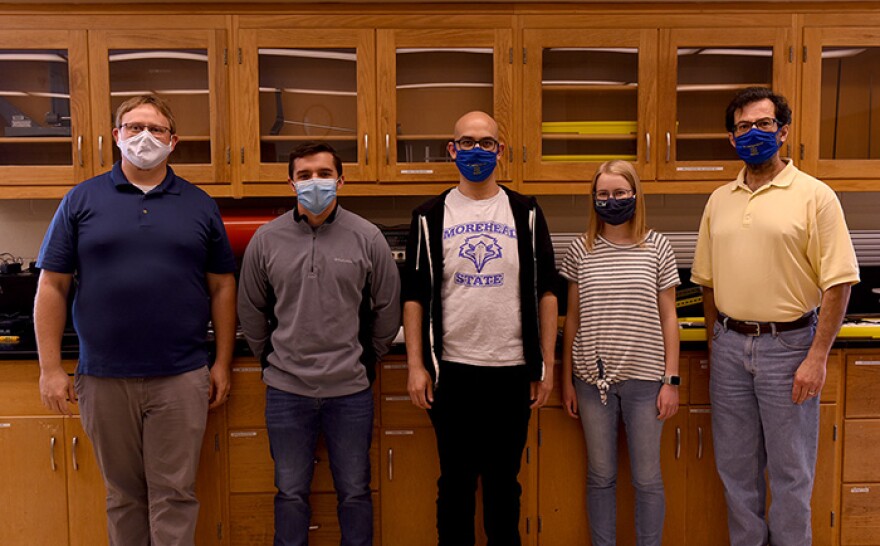Three undergraduate students recently presented their physics research at the American Physical Society's nuclear physics meeting, held virtually April 17-21.
The students were Eddie Henderson, senior physics major from Mt. Sterling; Anna Grace Ehr, junior biomedical sciences major from Lawrenceburg, and Jacob Gooslin, senior physics major from Lexington. Gooslin and Ehr were mentored by Dr. Ignacio Birriel, professor of physics, and Henderson was mentored by Birriel and Dr. Kevin Adkins, assistant professor of physics.
Henderson's project is titled "Monitoring Radiation Output from an Ohio Shale Outcrop in East Kentucky." He monitored radiation output from an outcrop near the Cave Run Lake Dam. Outcrops are rocky mounds commonly seen near interstates or along backroads.
"People build houses, grow crops and roads are really close to these things. We were curious about the potential health hazards these outcrops might pose," Henderson said.
He spent more than two years working with Birriel and Adkins, collecting and analyzing radiation data from the area. Adkins said it's good to have a student working on research for an extended period.
"It has been great to have him on this project for so long. Projects tend to change over time in both scope and methods," he said. "Having a student with a long background on the project made those changes very fluid for him as a student and for Ignacio and me as mentors."
"Science is a lot of trial and error, rarely do you get the answer even close to right on the first try. It's all about failing and learning from that," Henderson said. "When I was listening to the other students talk about their research, a lot of it was stuff that we were learning in our courses. So, I guess I was expecting a lot of the research to be over my head, but in reality, a lot of it I had seen before, so it felt good to see something from my field and knowing that I could understand what was going on."
Ehr's research sought to find the mass attenuation coefficient for a medical gel used to simulate blood clots and brain tissue. The mass attenuation coefficient is a measure of how much radiation the gel absorbs. By modifying an experiment Birriel already used in his classes, Ehr said they could tailor the research to her interest in biomedical science.
"Through this research, I was able to experience creating and conducting an experiment from start to finish. It was really cool to come up with this idea and see it actually produce results worth presenting at a national conference," she said. "I also learned a lot about nuclear physics, which is an area that is not explored in-depth in any of the classes required for my major."
Gooslin's research explored the anode heel effect at beam energies of 75kV and 140kV. The anode heel effect refers to a decrease in the intensity of an X-ray beam from the cathode side to the anode side. This experiment, conducted at the Tri-State Regional Cancer Center in Ashland, used a quality assurance detector array called an ArcCHECK to create beam profiles and dose distribution plots for X-ray beam energies of 75kV and 140kV to study the effects of the beams.
Gooslin said he plans to be a medical physicist, and the research he and Birriel conducted gave him a taste of what that career will be like.
"I wanted some exposure to research involving radiation. Even though an X-ray is a diagnostic procedure and I wish to be more involved with therapeutic radiation procedures, the basic physical ideas behind the radiation generation are the same. So, I really wanted to be a part of a project that explored the topic of radiation," Gooslin said.
Birriel said students learn a broad range of skills from presenting research at professional conferences.
"When presenting their research at a conference, students learn time management and targeted communication," Birriel said. "There is limited time to transmit specific information to your audience. They must learn how to convince an audience that their work has value and so they learn to answer the question of why their work matters and why others should care. Finally, they learn to be confident in their own 'expertise' since they are the only person who knows the details and nature of their work."
For more information about physics programs at MSU, visit http://www.moreheadstate.edu/phes or email phes@moreheadstate.edu or call 606-783-2381.



